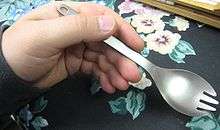Spork

A spork is a hybrid form of cutlery taking the form of a spoon-like shallow scoop with two to four fork tines.[1] Spork-like utensils, such as the terrapin fork or ice cream fork,[2] have been manufactured since the late 19th century;[3] patents for spork-like designs date back to at least 1874, and the word "spork" was registered as a trademark in the US and the UK decades later. They are used by fast food restaurants, schools, prisons, the military, backpackers and in airline meals.
The word spork combines spoon and fork. Similarly, the word foon is a blend of fork and spoon. The word "spork" appeared in the 1909 supplement to the Century Dictionary, where it was described as a trade name and "a 'portmanteau-word' applied to a long, slender spoon having, at the end of the bowl, projections resembling the tines of a fork".
History



In the US, patents for sporks and proto-sporks have been issued. A combined spoon, fork, and knife closely resembling the modern spork was invented by Samuel W. Francis and issued U.S. Patent 147,119 in February 1874.[4] Other early patents predating the modern spork include U.S. Patent 904,553,[5] for a "cutting spoon", granted on November 24, 1908 to Harry L. McCoy and U.S. Patent 1,044,869,[6] for a spoon with a tined edge, granted to Frank Emmenegger in November 1912. Many of these inventions predated the use of the term "spork". Given this significant prior art, the basic concept of combining aspects of a spoon and fork is well established; more modern patents have limited themselves to the specific implementation and appearance of the spork. These design patents do not prevent anyone from designing and manufacturing a different version of a spork. Examples of modern US design patents for sporks include patent number D247,153 issued in February 1978[7] and patent D388,664 issued in January 1998.[8]
The word spork originated in the early 20th century to describe such devices. In 1951, Hyde W. Ballard of Westtown, Pennsylvania filed an application with the United States Patent Office (USPO; now the United States Patent and Trademark Office) to register "Spork" as a trademark for a combination spoon and fork made of stainless steel.[9][10] The Van Brode Milling Company subsequently registered SPORK for a combination plastic spoon, fork and knife at the USPO on October 27, 1970, but the registration expired 20 years later.[11] The word Spork accompanied by a stylised design is registered in the U.S. in relation to hand tools, in the name of a UK-based individual.[12]
In the UK, Plastico Limited registered Spork as a trademark in relation to cutlery with effect from September 18, 1975 (reg. no. 1052291). The registration is now in the name of another company and remains in force. The trademark is also registered in the UK in relation to gardening tools in the name of the same UK based individual who owns US trademark registration no. 2514381. Another British company, Lifeventure, sells titanium and plastic versions using the name "Forkspoon".
In an unsuccessful lawsuit in 1999 where the company Regalzone sought to invalidate Plastico Limited's UK registration for Spork, Justice Neuberger wrote:
I accept that the word Spork involves a clever idea of making a single word by eliding beginning of the word spoon and the end of the word fork. The fact that it is clever and the fact that the meaning of Spork could be said to be obvious once it is explained does not mean that it is obvious what it is. Indeed, I would have thought that if one asked a person in 1975 what a Spork was, he or she would not know. If one then explained what it was and how the word came about, one might then be told that it was obvious or that it was clever.
Materials and uses

Materials such as stainless steel, silver, aluminum, titanium, and polycarbonate plastic have been used in spork manufacture. Plastic sporks are common in prisons in the United States because they are difficult to form into shiv-type weapons. Prepackaged meals may come with a disposable plastic spork. Sporks are also frequently used by backpackers and other outdoorsmen as they are a lightweight and space-saving alternative to carrying both a fork and spoon.
See also
- Grapefruit spoon
- Knork
- Lusikkahaarukka (spoon-fork in Finnish)
- Pastry fork
- Runcible spoon
- Spife
- Splayd
- Sporf
References
- ↑ Shepard, Helen-Marie (27 May 2002). "The splendid spork a marvel to behold". The Register Guard. Retrieved 1 February 2009.
- ↑ Petroski, Henry (1992). The Evolution of Useful Things. Knopf. p. 135. ISBN 0-679-41226-3.
- ↑ "Terrapin Forks (1890 - 1900)". Prices 4 Antiques.
- ↑ U.S. Patent 147,119
- ↑ U.S. Patent 904,553
- ↑ U.S. Patent 1,044,869
- ↑ U.S. Patent D247,153
- ↑ U.S. Patent D388,664
- ↑ U.S. trademark application, serial no. 609,277, filed January 26, 1951. Official Gazette of the United States Patent Office, vol. 665, no. 3, p. 673, December 16, 1952. Accessed April 2, 2014.
- ↑ Jones, Stacy V. (December 20, 1952). "Small Fry Attempting to Get Peek At Yule Gifts May Be Caught in Act: Device Resembling Mouse Trap Registers Every Time Door Is Opened -- Another Patent Covers Rubber Beanie -- List of Inventions Patented In Week". New York Times. pp. 23, 27.
Hyde W. Ballard of Westtown, Pa., has applied for trade-mark registration of "SPORK" for a combination spoon and forkmade of stainless steel.
- ↑ U.S. trademark registration no. 901,492, filed October 24, 1969, registered October 27, 1970. Accessed April 2, 2014.
- ↑ U.S. trademark registration no. 2,514,381, filed March 23, 2000, registered December 4, 2001. Accessed April 2, 2014.
- D. Green & Co. (Stoke Newington) Ltd. and Plastico Ltd. v Regalzone Ltd. [2002] ETMR 241 (CA)
External links
| Wikimedia Commons has media related to sporks. |
| Wikiquote has quotations related to: Spork |
- The Straight Dope on sporks
- The spork’s weird history, Bee Wilson, Salon